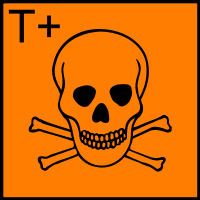|
Empirical Formula (Hill Notation)
|
C22H25NO6
|
|
Purity
|
≥95% (HPLC)
|
|
Gene Information
|
human ... ABCB1(5243), CYP3A4(1576)mouse ... Abcb1a(18671), Abcb1b(18669)
|
|
Apperance
|
white to yellow powder
|
|
Melting Point
|
150-160 °C (dec.)(lit.)
|
|
Solubility
|
ethanol: soluble50 mg/mL
|
|
GHS Pictograms
|

|
|
GHS Pictograms
|

|
|
GHS Pictograms
|

|
|
GHS Signal Word
|
Danger
|
|
GHS Hazard statements
|
H300 + H330-H318-H340
|
|
European Hazard Symbols
|
 Highly toxic (T+) Highly toxic (T+)
|
|
MSDS Link
|
Download
|
|
Personal Protective Equipment
|
Eyeshields, Faceshields, full-face particle respirator type N100 (US), Gloves, respirator cartridge type N100 (US), type P1 (EN143) respirator filter, type P3 (EN 143) respirator cartridges
|
|
GHS Precautionary statements
|
P201-P260-P264-P280-P284-P301 + P310
|
|
RID/ADR
|
UN 1544 6.1/PG 1
|
|
Risk Statements
|
46-28
|
|
RTECS
|
GH0700000
|
|
Safety Statements
|
53-45
|
|
Hazard Class
|
6.1
|
|
UN Number
|
1544
|
|
Packing Group
|
1
|
|
German water hazard class
|
3
|